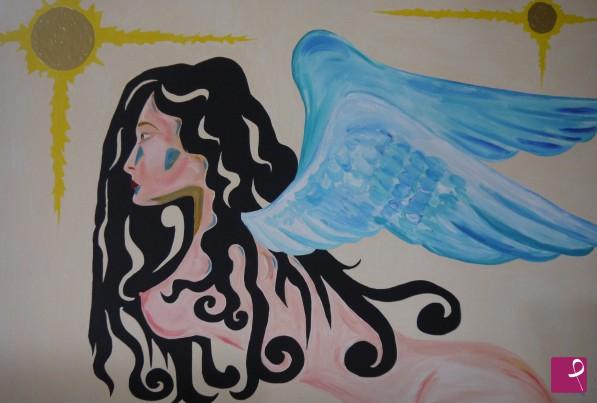Angel Nike

Descrizione
ANGEL NIKE
Acrilico su tela
70 x 100
Nike, strettamente legata alla dea Atena, è una figura della mitologia greca, sorella di Cratos, la Potenza, Bia, la Forza e Zelos l’Ardore; agile e splendida, personifica la Vittoria Alata: con le ali spiegate, pronte ad alzarsi in volo verso l’Olimpo degli dei, per portare in trionfo il nome del vincitore, innalzandolo al di sopra dei comuni mortali. La Nike di Samotracia, attribuita al grande scultore classico Fidia, ritrovata senza braccia e senza testa, era probabilmente collocata sulla prua della nave. Una polena, dunque, per esorcizzare gli spiriti nel complicato rapporto che lega l’uomo al mare, fatto di paura, ma anche di sfida. Ma l’opera si rifà anche all’iconografica angelica, agli abitanti dei mondi invisibili. La parola "angelo" proviene dal greco "anghelos", cioè "messaggero". Gli angeli, infatti, vengono sovente inviati come messaggeri agli uomini. Pseudo-Dionigi l'Areopagita ne parla del De coelesti hierarchia. Qui il messaggio è quello relativo agli innumerevoli mondi, tratteggiati e ricorrenti nell’opera di Mina Cappussi, il cui mondo interiore “parla” attraverso immagini dal sapore onirico
Angel Nike
Nike, closely linked to the goddess Athena, is a figure in Greek mythology, the sister of Cratos, the Power, Bia, the Force and Zelos, the Ardor; beautiful, she personifies the Winged Victory: with outstretched wings, ready to take off towards the Olympus of the gods, to bring in triumph the name of the winner, raising it above mere mortals. The Nike of Samothrace, attributed to the great classical sculptor Phidias, found headless and armless, was probably placed on the bow of the ship. A figurehead, therefore, to exorcise the spirits in the complicated relationship between the man and the sea, made out of fear, but also challenging. therefore the painting also draws angelic Iconography, to the inhabitants of the invisible worlds. The word "angel" comes from the greek "anghelos," meaning "messenger". The angels, infact, are often sent as messengers to people. Pseudo-Dionysius the Areopagite speaks of them in De Coelesti Hierarchia. Here the message is related to the countless worlds, dashed and recurring in the work of Mina Cappussi, whose inner world "speaks" through images from dreamlike flavor
0 commenti
registrati o accedi per lasciare un commento











